You've probably read on other threads that a lot is going on.
Right now, me and other developers at the IRC are working hard (day and night) to find any remaining problems with the Pyra hardware... we already found a couple of ones, but most are quick and simple fixes without any changes or redesigns needed.
There's a LOT going on, pretty exciting times.
aTc has created a current version of the PyraOS which work on the latest prototypes. This is the image that will lead to the OS that you will get preinstalled on the Pyra...
You've probably seen it on the pictures on twitter or the boards.
So much for a small introduction, let's continue with the structured news.
1. The Case
Awww... still not there?
Nope, I still don't have it, sadly. And yes, it's taking awfully long and I am myself not happy about that.
That's also the reason I've been in almost daily contact with my contact person there (who is an experienced plastics 3D designer as well).
Here's a bit of background info what happened:
While I was waiting for the final cases, another few issues had been found:
My contact received the final 3D data for the current molds and will check them thoroughly for any issues and he'll also visit the company on the production day to inspect the cases, especially regarding the issues we had (shoulder buttons, stylus, battery compartment) to make sure they are working fine before they're being sent to me.
Form Action plans the production run either this or next week, and I really do hope it's being kept.
Otherwise, I can always fly over to Greece to make sure things will move forward - something not easily possible when producing in China.
2. The keymat
The new keymats are still planned to arrive within this week at the austrian company which is handling the design and production of it.
As soon as I receive them, I'll know.
If I don't hear anything back this week, I'll check if there's any update.
3. The hardware
As mentioned above, that's the main thing we're now heavily working, testing, etc.
Thanks a lot to zmatt, slaeshjaeg, aTc, urjaman and any other dev who is currently helping out in IRC with all the testings, finding issues and especially possible solutions!
It really helps a lot with that beast - the Pyra is pretty complex, probably way complex for just one person (Nikolaus) so having capable others looking into it is great.
So far, we've found a couple of issues with simple fixes (like not populating some parts or replacing them with 0 Ohm resistors), and one issue that MIGHT be a problem... but more tests are needed.
What's the issue? Well, here you go:
You probably know that we've got an internal MicroSD Card slot and the eMMC and you can either use (or boot) from one or the other.
So far so good, we're using a switch (MUXer) for that. The switch supports SD Cards up to 96Mbps (should be UHS-3) - however, the eMMC would be able to run with up to 192Mbps (so about twice as fast).
And that's the problem: By using that switch, we've accidentally crippled the SD Card speed (which was certainly not what we planned) - and as that switch is on the CPU Board where 570 have already been produced, it's not easy to fix that.
What does that mean? Well, in theory, the read speeds of the eMMC on our CPU board would be quite a bit slower than it should.
However, how much slower is something we still need to test (we're working on that. Nikolaus is also modifiying one CPU board so we can test the speed without the switch as well).
Does that even have an effect in reality?
That's something we still need to test (we only found out about that yesterday, so we haven't finished all tests).
Some information here...
So too early to make final decisions yet, but of course I'll let you know more after the tests.
If there's no other limiting factor (like the CPU, etc.), then the difference when loading a 100MB/s file would be a loading time of approx. 1,2s compared to 0,6 - 0,7s.
If the program that needs the data can't handle it that fast, the difference will be even less.
So what will happen if that really turns out to be an issue?
Well, we could throw 570 CPU boards away (which would cause a loss of 7500 EUR).
We could sell them as keychains (for 15 EUR each), without any loss.
We could also finish these boards as planned and assemble units which anyone who would want to get it as fast as possible.
We haven't decided anything, as that depends on the output of our tests.
So looking good, and hopefully, we won't find any more issues (unless these are easily fixable ones), so we can order the Mainboard and Displayboard as well (maybe next week).
4. The LCD Cable
You've probably seen some pictures where you can see that I modified the LCD Cable as well.
Why did I do that - when the old one was working?
Yes, they were working fine - but Askarus designed them to be rolled four times... which is possible, but takes too long (which I've found out assembling the prototypes).
So I sat down for a while (over 10 hours, actually!) designing, cutting, changing, cutting again, redesigning, etc.
I tried out tons of different ideas, and I'm very happy of the outcome of the new one.
Check the preview picture:
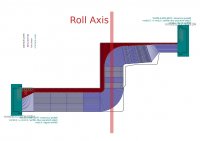
So, what's special about the cable?
What's great is that the traces will roll in PARALLEL to the roll axis (the red one in the picture).
That means that no real force is applied to them which will lower the risk of a damage A LOT.
Additionally, as ALL traces are redundant in the full roll-area, it's VERY unlikely that the cable will break.
The cable has been designed to fit perfectly in length and is easy to be rolled and assembled.
I'll receive a dummy sample in about 10 days and then we can submit the final data for production (production time of the LCD cables is about 3 weeks).
Whew.
That's it for today.
And here are some pictures I took today with my crappy Smartphone in my hotel room... a Pyra prototype running the current OS version.
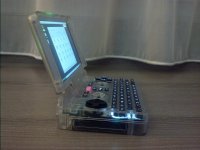

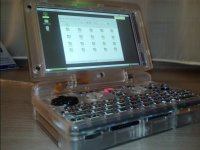
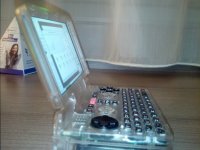
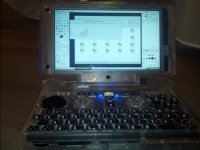
The screen is gorgeous (though you can't really see that thanks to the crappy phone), but I especially like the viewing angle... just take a look at the picture where you see the Pyra from the side: The picture is still viewable, no discolorations or brightness differences.
Awesome!
BTW: I'm doing the tax stuff for the Pyra right now... so I'll make a post within the next few days which shows how much the Pyra has cost so far and where the money went.
Some of you might be interested in that.
Right now, me and other developers at the IRC are working hard (day and night) to find any remaining problems with the Pyra hardware... we already found a couple of ones, but most are quick and simple fixes without any changes or redesigns needed.
There's a LOT going on, pretty exciting times.
aTc has created a current version of the PyraOS which work on the latest prototypes. This is the image that will lead to the OS that you will get preinstalled on the Pyra...
You've probably seen it on the pictures on twitter or the boards.
So much for a small introduction, let's continue with the structured news.
1. The Case
Awww... still not there?
Nope, I still don't have it, sadly. And yes, it's taking awfully long and I am myself not happy about that.
That's also the reason I've been in almost daily contact with my contact person there (who is an experienced plastics 3D designer as well).
Here's a bit of background info what happened:
While I was waiting for the final cases, another few issues had been found:
- The keymat company found out that the space for the keyboard keys is a bit smaller than it should be. So the keys are a bit tight inside the case. We've sent the exact measurements to Form Action Greece and they fixed that right away.
- While assembling the protoypes, two LCDs cracked - that's not something that should happen! So I looked for the reason... and I found two, actually.
- The final version of the touchscreen actually is a TINY bit bigger (0,2mm) than the previous one! Easy fix for the prototypes and as I sent Form Action one of the cracked screens for size comparison, it's also already fixed in the molds.
- Even assembling the lid without an LCD or display board was hard. A lot of force was needed - both parts simply didn't fix properly. Which was weird, as these were working perfectly before and hadn't been changed. So I asked my contact whether he had an idea how that happened... and yes, he had: That's a typical problem of a too-rushed production, where the parts cool off too fast. So nothing is wrong with the molds, but whoever made the production run was in a hurry and didn't do it properly.
My contact received the final 3D data for the current molds and will check them thoroughly for any issues and he'll also visit the company on the production day to inspect the cases, especially regarding the issues we had (shoulder buttons, stylus, battery compartment) to make sure they are working fine before they're being sent to me.
Form Action plans the production run either this or next week, and I really do hope it's being kept.
Otherwise, I can always fly over to Greece to make sure things will move forward - something not easily possible when producing in China.
2. The keymat
The new keymats are still planned to arrive within this week at the austrian company which is handling the design and production of it.
As soon as I receive them, I'll know.
If I don't hear anything back this week, I'll check if there's any update.
3. The hardware
As mentioned above, that's the main thing we're now heavily working, testing, etc.
Thanks a lot to zmatt, slaeshjaeg, aTc, urjaman and any other dev who is currently helping out in IRC with all the testings, finding issues and especially possible solutions!
It really helps a lot with that beast - the Pyra is pretty complex, probably way complex for just one person (Nikolaus) so having capable others looking into it is great.
So far, we've found a couple of issues with simple fixes (like not populating some parts or replacing them with 0 Ohm resistors), and one issue that MIGHT be a problem... but more tests are needed.
What's the issue? Well, here you go:
You probably know that we've got an internal MicroSD Card slot and the eMMC and you can either use (or boot) from one or the other.
So far so good, we're using a switch (MUXer) for that. The switch supports SD Cards up to 96Mbps (should be UHS-3) - however, the eMMC would be able to run with up to 192Mbps (so about twice as fast).
And that's the problem: By using that switch, we've accidentally crippled the SD Card speed (which was certainly not what we planned) - and as that switch is on the CPU Board where 570 have already been produced, it's not easy to fix that.
What does that mean? Well, in theory, the read speeds of the eMMC on our CPU board would be quite a bit slower than it should.
However, how much slower is something we still need to test (we're working on that. Nikolaus is also modifiying one CPU board so we can test the speed without the switch as well).
Does that even have an effect in reality?
That's something we still need to test (we only found out about that yesterday, so we haven't finished all tests).
Some information here...
- Linux doesn't access the eMMC that often. We're not using Windows here (which accesses the harddisk all of the time), but Linux. And Linux usually has very little disk access. Once it has booted up, it doesn't need to load a lot of stuff. In fact, the only things I can think of where fast read/write rates would be important would be a swap file... and that shouldn't be on an eMMC anyways.
- Even if programs have high disk access, it could very well be the CPU is a limiting factor. If a program needs some time to analyze or unpack the data it loads, it wouldn't load things faster, even if the storage would be a lot faster.
- It's also unknown whether the theoretical speed would be reachable anyways. I've often seen "Speeds up to xxx" whereas in reality, it was a lot slower.
- It's still a multiple times faster than the Pandora and could reach speeds only UHS-2 and UHS-3 SD Cards support. So "slow" isn't really "slow" here.
So too early to make final decisions yet, but of course I'll let you know more after the tests.
If there's no other limiting factor (like the CPU, etc.), then the difference when loading a 100MB/s file would be a loading time of approx. 1,2s compared to 0,6 - 0,7s.
If the program that needs the data can't handle it that fast, the difference will be even less.
So what will happen if that really turns out to be an issue?
Well, we could throw 570 CPU boards away (which would cause a loss of 7500 EUR).
We could sell them as keychains (for 15 EUR each), without any loss.
We could also finish these boards as planned and assemble units which anyone who would want to get it as fast as possible.
We haven't decided anything, as that depends on the output of our tests.
So looking good, and hopefully, we won't find any more issues (unless these are easily fixable ones), so we can order the Mainboard and Displayboard as well (maybe next week).
4. The LCD Cable
You've probably seen some pictures where you can see that I modified the LCD Cable as well.
Why did I do that - when the old one was working?
Yes, they were working fine - but Askarus designed them to be rolled four times... which is possible, but takes too long (which I've found out assembling the prototypes).
So I sat down for a while (over 10 hours, actually!) designing, cutting, changing, cutting again, redesigning, etc.
I tried out tons of different ideas, and I'm very happy of the outcome of the new one.
Check the preview picture:

So, what's special about the cable?
What's great is that the traces will roll in PARALLEL to the roll axis (the red one in the picture).
That means that no real force is applied to them which will lower the risk of a damage A LOT.
Additionally, as ALL traces are redundant in the full roll-area, it's VERY unlikely that the cable will break.
The cable has been designed to fit perfectly in length and is easy to be rolled and assembled.
I'll receive a dummy sample in about 10 days and then we can submit the final data for production (production time of the LCD cables is about 3 weeks).
Whew.
That's it for today.
And here are some pictures I took today with my crappy Smartphone in my hotel room... a Pyra prototype running the current OS version.





The screen is gorgeous (though you can't really see that thanks to the crappy phone), but I especially like the viewing angle... just take a look at the picture where you see the Pyra from the side: The picture is still viewable, no discolorations or brightness differences.
Awesome!
BTW: I'm doing the tax stuff for the Pyra right now... so I'll make a post within the next few days which shows how much the Pyra has cost so far and where the money went.
Some of you might be interested in that.

